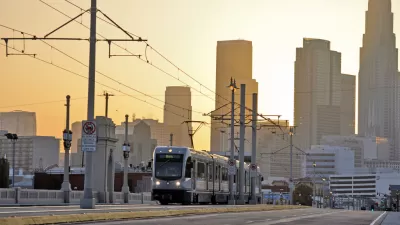Here in San Diego, public transportation is on life support. Despite record ridership, trolley and bus service has been reduced, with some bus routes cancelled altogether. Fares are up across the board. The monthly light rail pass will be $72; three years ago it was $60.
Here in San Diego, public transportation is on life support. Despite record ridership, trolley and bus service has been reduced, with some bus routes cancelled altogether. Fares are up across the board. The monthly light rail pass will be $72; three years ago it was $60.
Thank the governor and the state legislature in the midst of the budget crisis. In February 2009, California abolished the State Transit Assistance (STA) program, a $536 million fund that covers 70% of the operating costs for transit agencies across the state. According to the California Transit Association, it is "the only source of state funding for day-to-day transit operations". The program wasn't cut, it wasn't slashed – it fully disappeared, to the dismay of many national environmental organizations.
But the state still manages to find the money to widen freeways. The Sacramento Bee reported that during the budget negotiations, Governor Schwarzenegger continued "to call for deeper cuts in spending and waivers of environmental regulations to allow at least 10 highway projects to go forward this year". In sprawling east San Diego County, $80 million is on the way to support the expansion of Highway 52, freeing local funds for further expansions on Highway 76 and Interstate-15.
A month after transit was slashed, President Obama was in Orange County touting that the stimulus-assisted expansion of State Route 91 could create 2000 jobs. Yet in the same month, Orange County voted to lay off 400 transit workers and cut bus service by 25%. No federal stimulus dollars were provided to cover transit operating costs.
So it's all about spending priorities. And California is choosing to invest in car dependency, increased air pollution and sprawl construction – an agenda that is fully at odds with the governor's and the president's promised goals on the environment and climate change. We've traveled this path before and we know where it leads.

Manufactured Crisis: Losing the Nation’s Largest Source of Unsubsidized Affordable Housing
Manufactured housing communities have long been an affordable housing option for millions of people living in the U.S., but that affordability is disappearing rapidly. How did we get here?

Americans May Be Stuck — But Why?
Americans are moving a lot less than they once did, and that is a problem. While Yoni Applebaum, in his highly-publicized article Stuck, gets the reasons badly wrong, it's still important to ask: why are we moving so much less than before?

Research Shows More Roads = More Driving
A national study shows, once again, that increasing road supply induces additional vehicle travel, particularly over the long run.

Judge Halts Enforcement of Anti-Homeless Laws in Grants Pass
The Oregon city will be barred from enforcing two ordinances that prosecute unhoused residents until it increases capacity and accessibility at designated camping sites.

Advancing Sustainability in Los Angeles County Schools
The Los Angeles County Office of Education’s Green Schools Symposium brings together educators, students, and experts to advance sustainability in schools through innovative design, climate resilience strategies, and collaborative learning.

Using Old Oil and Gas Wells for Green Energy Storage
Penn State researchers have found that repurposing abandoned oil and gas wells for geothermal-assisted compressed-air energy storage can boost efficiency, reduce environmental risks, and support clean energy and job transitions.
Urban Design for Planners 1: Software Tools
This six-course series explores essential urban design concepts using open source software and equips planners with the tools they need to participate fully in the urban design process.
Planning for Universal Design
Learn the tools for implementing Universal Design in planning regulations.
City of Moreno Valley
Institute for Housing and Urban Development Studies (IHS)
City of Grandview
Harvard GSD Executive Education
NYU Wagner Graduate School of Public Service
City of Cambridge, Maryland
Newport County Development Council: Connect Greater Newport




























